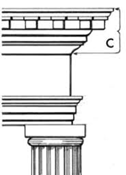This set of Civil Engineering Drawing Questions and Answers for Freshers focuses on “Units of Measurement and Payment for Various Items”.
1. Earthwork in plinth filling is calculated by taking _____________
a) External dimensions b/w plinth walls
b) Vertical dimensions b/w plinth walls
c) Internal dimensions b/w plinth walls
d) Total dimensions b/w plinth walls
View Answer
Explanation: In architecture, a plinth (from French plinthe, from Latin plinthus, from Greek πλίνθος plinthos, “brick”) is the base or platform upon which a column, pedestal, statue, monument or structure rests. Gottfried Semper’s The Four Elements of Architecture (1851) posited that the plinth, the hearth, the roof, and the wall make up all of architectural theory. The plinth usually rests directly on the ground or stylobate. According to Semper, the plinth exists to negotiate between a structure and the ground. Semper’s theory has been influential in the development of architecture.
2. In estimated cost what is the value taken for contingencies?
a) 0.5%-2.5%
b) 3%-5%
c) 5%-6%
d) 0%
View Answer
Explanation: The dictionary meaning of contingencies is defined as- A future event or circumstance
which is possible but cannot be predicted with certainty or a provision for a possible event or
circumstance. In engineering is said to be as an incidental expense.
3. Multiplying factor for prefix “atto” is _______
a) 10-8
b) 1018
c) 10-18
d) 108
View Answer
Explanation: Multiplying factor for prefix “atto” is 10-18.
4. In which unit, masonary of thin partition wall is calculated?
a) sq m
b) cu m
c) sq ft
d) sq cm
View Answer
Explanation: A partition wall is a wall that separates rooms, or divides a room. Partition walls are usually not load-bearing. Partition walls are constructed of many materials, including steel panels, bricks, blocks of clay, terra-cotta, concrete, or glass blocks.
Some partition walls are made of sheet glass. Glass partition walls are a series of individual toughened glass panels mounted in wood or metal framing. They may be suspended from or slide along a robust aluminium ceiling track. The system does not require the use of a floor guide, which allows easy operation and an uninterrupted threshold.
5. No deduction is made for?
a) Rectangular openings >1 sq ft
b) Arch masonary
c) Bed plate upto 4″depth
d) Lintels over openings
View Answer
Explanation: The Bedplate is the foundation on which the 2 stroke engine is built. It must be rigid enough to support the weight of the rest of the engine, and maintain the crankshaft, which sits in the bearing housings in the transverse girders, in alignment.
6. Large cornice is measured in ________
a) q ft
b) g ft
c) r ft
d) t ft
View Answer
Explanation: A cornice (from the Italian cornice meaning “ledge”) is generally any horizontal decorative molding that crowns a building or furniture element – the cornice over a door or window, for instance, or the cornice around the top edge of a pedestal or along the top of an interior wall. A simple cornice may be formed just with a crown.
The function of the projecting cornice of a building is to throw rainwater free of the building’s walls. In residential building practice, this function is handled by projecting gable ends, roof eaves, and gutters. However, house eaves may also be called “cornices” if they are finished with decorative molding. In this sense, while most cornices are also eaves (in that they overhang the sides of the building), not all eaves are usually considered cornices – eaves are primarily functional and not necessarily decorative, and a cornice has a decorative aspect to it.

Here the part C represents cornice.
7. For computing painting estimate for a venetian what times area is considered?
a) 2 times 1 surface area, both sides
b) 1 times 1 surface area,1 side
c) 1 times 1 surface area, for both sides
d) 3 times 1 surface area, both sides
View Answer
Explanation: In Italy it is one of the most common and appreciated decorative plaster. We are talking about the Venetian plaster. The polished and coloured surface is a tradition since ancient Roman times, pozzolona dust is used, that is a sand of volcanic origin and it is responsible for making the surface polished and smooth, but you can also use marble dust or coloured pigments of quartz mixed with lime. History tells that this technique was improved during the Seventeenth and Eighteenth centuries in Venice, that is the reason why it is called “Venetian”, also called Roman plaster.
The more layers of Venetian plaster are applied, the more polished and extremely refined is the wall. Obviously it also more expensive because of the labor it needs.
8. Estimation cost provided for water supply and electrification is __________
a) 4% and 6%
b) 18% and 18%
c) 08% and 08%
d) 12% and 15%
View Answer
Explanation: Pipes must be installed to meet requirements for durability, safety and thermal performance-
• contractor responsibilities
• general installation requirements
• where to lay pipework
• access for maintenance and replacement
• preventing electric shock
• pipe insulation.
Sanfoundry Global Education & Learning Series – Civil Engineering Drawing.
To practice all areas of Civil Engineering Drawing for Freshers, here is complete set of 1000+ Multiple Choice Questions and Answers.
If you find a mistake in question / option / answer, kindly take a screenshot and email to [email protected]
- Apply for Civil Engineering Internship
- Check Civil Engineering Drawing Books
- Check Civil Engineering Books
- Practice Civil Engineering MCQs
